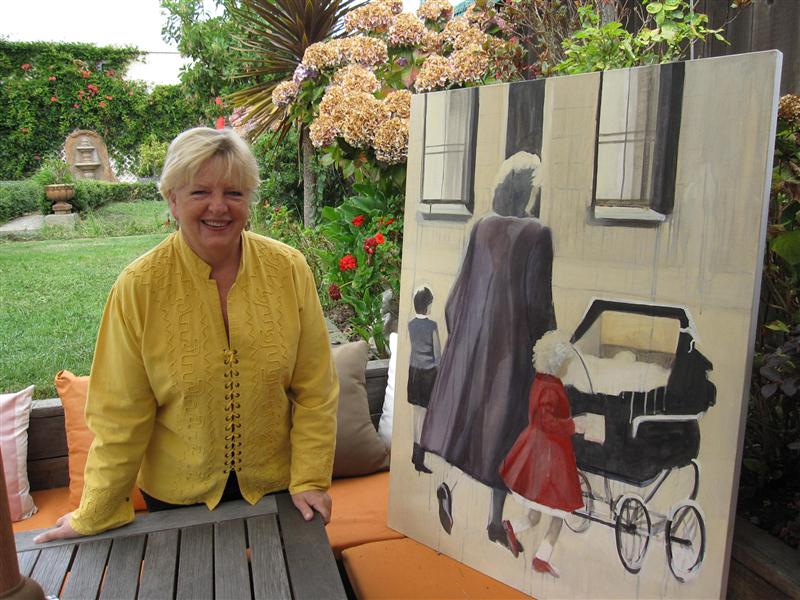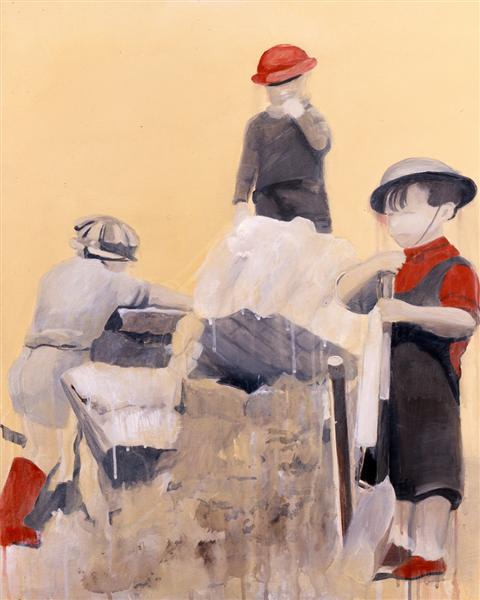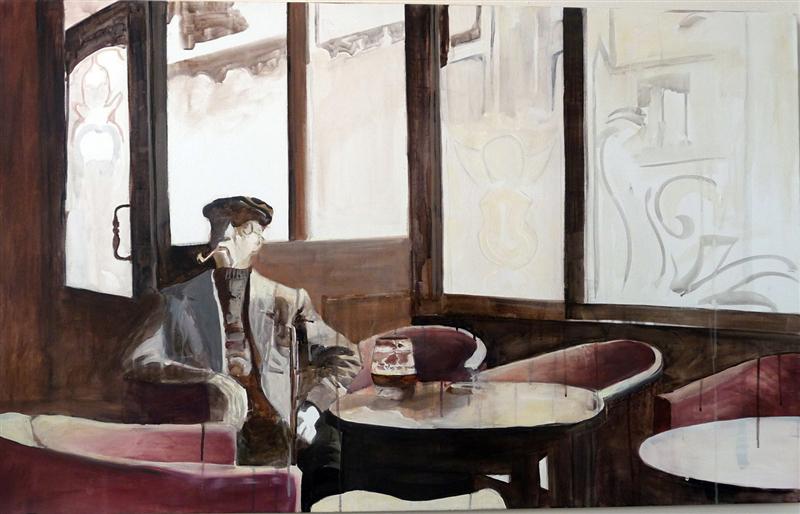
RETURN TO HOME PAGE
FEEDBACK
 |
October 2010 RETURN TO HOME PAGE FEEDBACK |
 |
| Though her childhood in England was harsh, Irene Hendrick has spent much of her artistic career returning to the imagery of her youth. Here she poses with a painting titled Walkin’ Just the Same. Photo by Pamela Gerard |
By Olivia Boler
Noe Valley artist Irene Hendrick grew up in a London housing project known by its residents as the Dungeon. “It was very dark,” she says. “There was no electricity until the 1960s, no bathroom. Just gas lamps with a coal chute outside and a toilet in the kitchen. We bathed in a tin bath, and everything in the flat was mildewed from the dampness and condensation.”
The project was located in the borough of Islington, in the center of the city. Today the neighborhood is posh—former Prime Minister Tony Blair lived there in the 1990s—but when the 60-year-old Hendrick was a child in the 1950s and ’60s, it was “horrible, with bombed-out ruins [from World War II]. We kids played on old piles of rubble because that’s what you did.”

Half of What We’ve Been Through Looking at her paintings—mostly acrylics on canvas—you can easily tell that Hendrick’s childhood has had a lasting effect on her psyche. Her painting “Half of What We’ve Been Through” depicts three little boys wearing World War II–era British army helmets and playing on some of the rubble she describes. Another, “Walkin’ Just the Same,” shows a woman pushing an old-fashioned baby buggy, or pram as they say in the U.K., a little girl by her side. The woman’s coat, with its wide shoulders, hearkens back to the fashion trends of the 1950s.
As the oldest of seven children with a father who was often not around, Hendrick held three jobs at the age of 16. While helping her mother support the family, she dreamed of a future filled with travel and adventure. That finally happened when she was 21, and all because of the way she speaks. A recruitment agency helped her get a job as a legal secretary in Chicago.
“The agency worked for American companies that wanted receptionists and secretaries with British accents,” she says with a smile. She made her way to San Francisco in 1972, where she met the man she would marry. They bought a house on Jersey Street in 1977, and Hendrick still lives there. She and her husband divorced in 1990. They have one daughter, Emily, who is 24.
Hendrick loved drawing and painting from an early age, but got more serious in her 40s. For the past 15 years, she has worked as a fulltime artist. She has exhibited at Caffe Museo in the Museum of Modern Art, as well as at numerous galleries and cafes around the Bay Area.
The struggles families sometimes face often come up in Hendrick’s work, as do images of children and women. While her own London roots are a huge influence, Hendrick finds inspiration in Noe Valley, too. “I go to Martha Brothers for coffee every morning, and perhaps I’ll see a group of young women pushing their three-wheeled buggies, and it gets me thinking about the times I’d see women walking down the streets in London with little kids,” she says.
Even though the past infuses her work, Hendrick’s bestselling print, “Untitled (Three Girls),” has a more modern feel. The viewer sees the backs of three young girls sitting side by side on a carriage. One wears a baseball cap, while the other two have their hair done up in careless ponytails. Paint appears to be dripping off the canvas—one of Hendrick’s trademarks. The original canvas, which sold for $6,000, is owned by Kaiser Hospital in Oakland.
Currently, Hendrick, who earned her BFA and a teaching credential in 1994 from Mills College, is working on a painting of a flamenco dancer and a female bullfighter. Each image was inspired by a movie, the first Strictly Ballroom, an Australian comedy about competitive dancing, and the second Talk to Her, a Spanish film about a female bullfighter who gets injured. “I like to put subjects together from different narratives and create a new one. It’s the story that interests me.” The painting will be ready for San Francisco Open Studios this month.
Hendrick’s studio is not in her home, but at Hunters Point Shipyard Studios. She also teaches watercolor classes and gives workshops there. She admits that as a working artist she has felt the effects of the recession. “For the people who can afford my original canvases, which go for $4,000 to $6,000, the economy hasn’t fazed them. But for those who buy my limited-edition framed prints, things that are in the $400 to $600 range, they’re taking more time to think over such a purchase.” Most of her paintings or prints are about three feet wide by four feet high.

An Afternoon Pint
Never one to shy away from hard work, Hendrick is a member of the Society of Visual Artists. The organization puts on artist fairs in tourist locations like Union Square. For that, Hendrick paints San Francisco scenes such as the Golden Gate Bridge, cable cars, and the Palace of Fine Arts. She keeps these prints small-scale and puts them in matte frames that are easy for tourists to pack in their luggage. They sell for $20 to $40. “It’s a completely different thing,” Hendrick says.
Hendrick prefers figure painting to landscapes, and she often paints her subjects facing away from the viewer or from the back. If the person in the painting is facing forward, his or her face is quite often nearly blank. “I’m going for a timelessness, a universal quality,” she explains. “I want people who look at my paintings to make up their own stories. They are narrative, but they could be about anything. That’s why I keep the faces vague. It’s whatever you want it to be.”
Irene Hendrick’s studio will be open for San Francisco Open Studios Oct. 30 and 31, from 11 a.m. to 6 p.m., at Hunters Point Shipyard, 400 Innes Avenue, Building 101. For more information about her paintings or classes, contact Hendrick at 641-8882 or sfclarky@comcast.net. Her website is www.irenehendrick.com.
Open Studios Month
Editor’s Note: San Francisco Open Studios spans five weekends in October. The second, Oct. 9 and 10, will feature artists with studios in Noe Valley, Glen Park, the Castro, Bernal Heights, Portola, and the Mission. You can pick up a free guide at local newsstands or go to www.artspan.org for a preview of artists’ work.